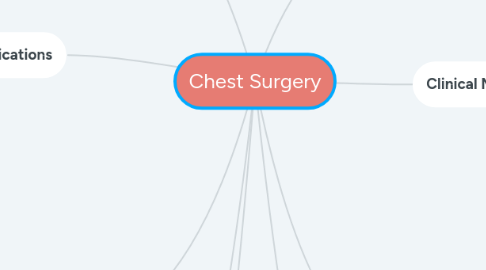
1. Lab and Diagnostics
1.1. X-rays
1.2. blood and urine samples
1.2.1. CBC
1.2.2. liver function
1.2.3. arterial blood gas
1.2.4. blood glucose
1.3. ECG
1.4. spirometry
2. Medications
2.1. analgesics, PCA/epidural
2.2. bronchodilators i.e. Ventolin
2.3. DVT and GI prophlaxis
3. Collaborative Interventions
3.1. deep breathing and coughing; demo how to splint chest
3.2. promoting ambulation; provide analgesic prior to mobilizing
3.3. wound assessments
3.3.1. assess incision, assess chest tube site,
3.4. O2 therapy
3.5. ROM
3.5.1. high risk of 'frozen shoulder'
3.6. pain management
3.7. prevention of skin breakdown
3.8. assess respiratory status ie RR, SaO2, breath sounds
3.9. chest tube care
3.9.1. keep loosely coiled below the level of the chest
3.9.2. assess tidaling with respiration;, if increase in bubbling may be a leak, spiral tape the connections for easy removal, suction at -20...need to be at 80 to 100 mgmHg on continous wall suction, assess for SQ emphysema , vaseline gauze around chest tube
4. types of surgeries
4.1. lobectomy
4.1.1. chest tube post op
4.1.2. position good lung down
4.2. wedge resection
4.3. Segmental resection
4.4. thoracotomy
4.5. pneumonectomy
4.5.1. **position surgical incision down to allow remaining lung to expand
5. medic
6. Risk Factors
6.1. trauma
6.2. heart surgery or esophageal surgery
6.3. tracheostomy
7. Clinical Manifestations
7.1. chest pain
7.2. SOB
7.3. cough
7.4. malignant effusion
8. Health Teaching
8.1. Discharge instructions
8.1.1. danger signs, when to return to the hospital, keep incison dry and clean,
8.2. incision care
8.2.1. left exposed to air as per policy, clean when in shower [if chest tube is removed and site dry]
8.3. signs of infection
8.3.1. increased redness
8.3.2. pus-like drainage
8.3.3. excess swelling
8.3.4. fever
8.3.5. elevated WBC
8.4. pain management
8.4.1. opioid, NSAID
8.5. danger signs
8.5.1. seek medical assistance if SOB, tachycardia, tachypnea,
